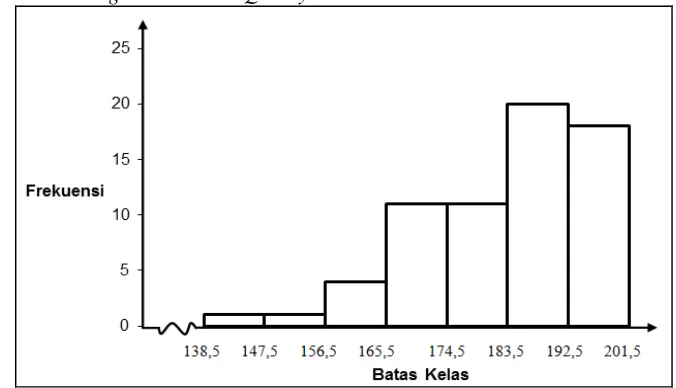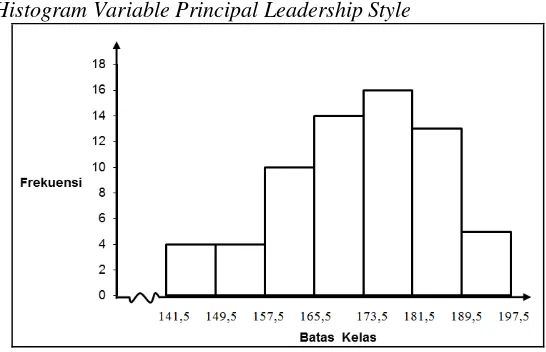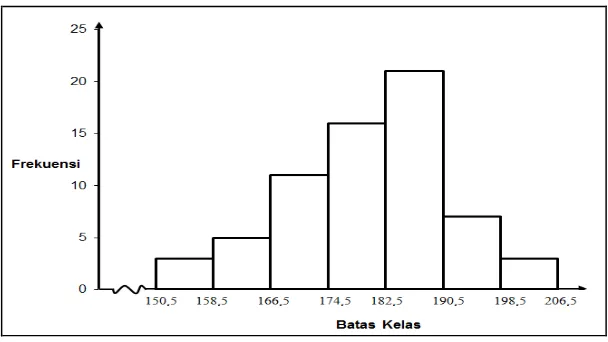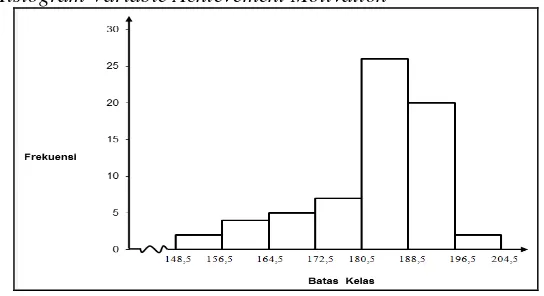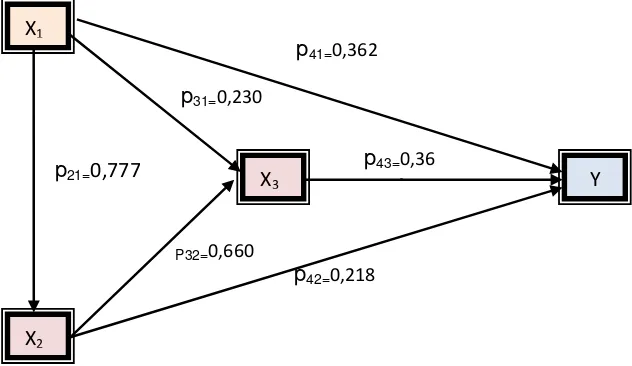Leadership Styles, Motivation Achievers and Quality in
Cultural Teaching
Siti Patimah
1Abstract:
This research was conducted in senior high schools in Gorontalo city. Approach used is quantitative research approach, with survey method. The population research are senior high school teachers as the city of Gorontalo about 375 people, the spread in 4 public schools and 3 private senior high schools in gorontalo city. The sample research consists of 66 teachers. Obtained by random way and the strata of sampling. Variable data from the research were collected using a questionnaire instrument, data analysis using statistical regression with significant levels α = 0,05.
The findings in this research as follows: (1) There is a positive relationship between principal leadership style to teacher’s work discipline, It means the principal leadership style is good and right will improve work discipline of the teacher (2) There is a positive influence on the principal of leadership style to teacher motivation achievers It means that the better the leadership style that is owned by the principal, hence up increasing the achiever motivation of teachers, (3) There is a positive influence on the principal of leadership style to quality culture teachers , it means that the better the leadership style that is owned by the principal, the more easily implement the quality culture in teachers, (4) There is a positive influence on motivation achievers to teacher’s work discipline. It means that the higher achievement motivation that teachers have, the more easily raise teacher’s work discipline, (5) There is a positive influence on teacher’s work discipline with quality culture teachers, it means the better the on teacher’s work discipline, the more easily apply quality culture teachers, (6) There is a positive influence teacher motivation achievers to quality culture teachers, it means that the higher motivation achievers teachers have the more easily apply quality culture teachers.
Keywords: Leadership Style, Principal, Discipline Of Work, Motivation Achiever, Quality Culture Teachers
I. Introduction
Low quality of education today is reflected in the results of National Examination student achievement. Until now, for all fields of study at junior and senior level have not shown significant increase, even virtually constant from year to year, except in some schools and even then with the relatively small amount. Results of National Examination achievements in general have not shown a significant increase. This can be seen in the comparison results of National Examination in the school by the National Examination results school year high school students as the city of Gorontalo. Based on data obtained from the Head of Section of the Department of Education high school curriculum Gorontalo City that the comparison is based on the achievement of passing the National Examination pure value that has not been added to the School Examination results is that for the 2013/2014 year graduation rate of 98% whereas for the 2014/2015 graduation rates 87 %. This shows that for the results of National Examination high school level in the city of Gorontalo even show significant decline.
In reality the other, where there is still a lot of principals who have not been able to show sufficient professionalism. This is caused partly because many principals who have not been able to apply leadership style well, the principal does not attempt to enforce discipline in carrying out the task, come and go home not in accordance with the set time.
Based on the data obtained in kepagawaian Gorontalo city education department, noted in the school year 2014/2015 has happened 20 times the turn of the principal both at the kindergarten, elementary, middle and high school / vocational and based informers obtained from the data source this is due partly to a lack of understanding of the principals of the leadership style so that in performing the task of leadership is always at odds with the wishes of the government and their subordinates.
Besides influenced by the style of leadership of the principal, teachers' efforts to improve the cultural quality can also be affected by the work Discipline teachers. School discipline high work easily achieve what is aspired or what is the vision and mission of the school, because in conditions like this all the components in it, including teachers and students have a great opportunity to foster and develop skills owned.
Thus it can be argued that the style of leadership of the principal, disciplined work of teachers and teacher achievement motivation influence on the birth of the culture of quality teachers. And to find out more about this effect it is necessary for scientific research on the topic "Effects of the principal's leadership style, achievement motivation and discipline to teacher quality culture".
education is perceived by service users and user education educational outcomes. In more detail Tenner and De Toro, (in the Technical Guidelines for Quality Management) defines that quality is "Quality: A basic business strategy that Provides and services that completely satisfy both internal and external customers by meeting Reviews their explicit expectation"
According Cortada (1996), quality culture can be defined as a set of norms that is based on the values and beliefs then manifested in behaviors, activities and symbols in school to reach the level of excellence expected and desirable and how to achieve it in order to create school accountability. Kamarudin (1990), suggests there are six grades of quality culture that became the basis for the quality culture as a whole: (1) We are all together, (2) There is no person under or superiors justified, (3) Open and nexus sincere, (4) Workers should achieve the required notices, (5) Focus on the process and (6) There is no triumph or failure, but learning rather than experience.
Lee Harvey and Bjorn Stensaker (2008) concludes thing to note in the implementation of quality culture, namely:
a. There is often an implicit cultural imperialism associated with quality culture, b. One should be careful in seeing quality culture as pre-defined, rather viewing it
as a way of life,
c. If the letter, quality culture is not mechanistic or codified, a system produced by specialists for adoption by others but an iterative, indeed dialectical, process of evolution that does not just focus on internal processes but relates them to a wider appreciation of social and political forces and locates them historically.
Sukrisna (2008), states that: Quality culture is an integral part of corporate culture. Corporate culture consists of habits, beliefs, values and behavior. The eight values are (1) purpose. Purpose is the vision stated in terms of product or service and benefit in the customer; (2) consensus. Three decision-making styles-command, consultative, and consensus-should be matched to particular situations; (3) excellence. Management creates an environment in which the pursuit of knowledge for improvement is pervasive; (4) unity. The emphasis here is on employee participation and ownership of work; (5) performance (Hakimi, D. Knippenberg and S. Giessner, S. 2010).
Paul Hersey and Kenneth H. Blanchard (1980) in his book entitled Management of Organizational Behavior, suggests the definition of leadership is the activity in influencing others to work hard with full willingness for the purpose of group (Ardichvili and Kuchinke, 2002).
style into four, namely: (1) authoritarian style, (2) the style laissez-faire, (3) a democratic force, (4) pseudo-democratic force.
Handoko and Tjiptono (1966), suggests that transformational leaders motivate subordinates to perform above and beyond the call of duty. Transformational essence of leadership is the sharing of power involving subordinates together to make changes (Den Hartog, 1999).
Based on the descriptions above theory, it can be concluded that the school's leadership style is a pattern that is owned by a school principal in carrying out his duties as a leader. In performing his duties as a leader principal have different leadership styles and are usually adapted to the conditions and habits prevailing in school. In general, the principal's leadership style can be seen through the following indicators: Characteristically open, dominating the execution of tasks, and situational (Jogulu and Uma, 2010; Kosinova et al., 2016; Sultanova and Chechina, 2016; Gorina, 2016; Guskova et al., 2016; Sazhin and Saraikin, 2016).
According to Koontz (1980), the motivation is the impetus of work that arises in a person to behave in achieving its intended purpose. Medium Duncan gives the following formula; motivation is a conscious effort to influence a person's behavior in order to lead to the achievement of organizational goals (from a managerial perspective, motivation Refers to any conscious attempt to influence behavior toward the accomplishment of organizational goals). Murphy and Alexander (2000), in the modern study of motivation, that assumption is the encouragement of individual, one's needs and goals are explicit knowledge that can be reflected and communicated to others. However, the current view emphasizes the importance of the unconscious in the human mind. Motivation as our brains, only in part can only access into introspection.
As is the achievement motivation of teachers in this study is the encouragement of the teachers themselves to do better than anything ever created earlier, with indicators: a willingness to go forward, served well, accepted the challenge, accept personal responsibility, and success (Jung et al., 1995).
Helmi (1996) indicators of labor discipline as follows, (1) submissive and obedient to the use of working hours, (2) comply with working hours not because of fear or necessity, and (3) the commitment and loyalty to the organization.
From the definitions presented above it can be concluded that the work discipline is loyalty and devotion a person or a group of the regulations reflected in the behavior and actions in the form of (1) submissive and obedient to the use of working hours, (2) comply hours work not because of fear or necessity, and (3) the commitment and loyalty to the organization (Locander et al., 2002).
II. Research Methodology
This research was conducted at the high school teacher - Gorontalo City and held for 6 months from September 2015 to February 2016. The study also categorized descriptive correlation research. It is descriptive because it will only describe the observed phenomena, whereas the correlation for attempting to explain the relationship between variables based on the size of the correlation coefficient. The study population is the overall high school teacher - Gorontalo. Members of the population are teachers who served in public and private high school in the city of Gorontalo amounted to 375 people. The instrument used in this study was a questionnaire to collect data of each variable. Data collection instruments are the tools selected and used by researchers in data collection activities so that these activities become systematic and easy (Suryanto, 2016). Instrument can study the form of questionnaires, interview guides, observation sheets and Scale. Analysis of measurement data quality culture obtained through this research is descriptive and inferential analysis. (Luanglath and Inpong, 2014).
III.Results and Discussion
A. Description of Data Research
a. Quality Culture
Based on field data obtained are then processed statistically obtained that Quality Culture variable has a value of average (mean) of 182.65 with 12.498 standard deviation, median (me) = 185. Furthermore, based on complete data in Annex 2 obtained the maximum score of 199 and minimum score of 139, so that the range of scores is equal to 60. The distribution of data from a culture of quality as in the table below:
Table 1: Score Frequency Distribution Quality Culture
No Class
Interval
Absolute Frequency
Relative Frequency (%)
1 139 - 147 1 1.52
2 148 - 156 1 1.52
4 166 - 174 11 16.67
5 175 - 183 11 16.67
6 184 - 192 20 30.30
7 193 - 201 18 27.27
Amount 66 100
Table 1 above illustrates that the variable frequency spread Quality Culture is a symmetrical curve. This is indicated by a score median and modes are close to the average. Quality Culture frequency distribution table above shows also that there were 11 (16.67) of respondents who are at average group, 11 (16.67) above the group average, and 4 (6.06) is below average. The distribution of the variable scores Quality Culture shown on Figure 1 below.
Figure 1: Histogram Variable Quality Culture
b. Principal Leadership Style
Principal leadership style variable has a value of an average of 173.06 with 13.054 standard deviation and median 175. Based on the complete data in Annex 1 obtained the maximum score of 192 and a minimum score of 142, so that the range of scores is 50.
Table 2: Score Frequency Distribution of Principal Leadership
No
Range Interval
Absolute Frequency
Relative Frequency (%)
1 142 – 149 4 6.06
2 150 – 157 4 6.06
3 158 – 165 10 15.15
4 166 – 173 14 21.21
5 174 – 181 16 24.24
7 190 – 197 5 7.58
Jumlah 66 100
Table 2 above shows that the spread of variable frequency Principal Leadership Style is a symmetrical curve. This is indicated by a score median and modes are close to the average. Quality Culture frequency distribution table above shows also that there are 14 (21.21) of respondents who are at average group, 16 (24.24) are above the average group, and 10 (15.15) is below average. The distribution of the variable scores Principal Leadership Style shown in Figure 2.
Figure 2. Histogram Variable Principal Leadership Style
c. Work Discipline
Based on the data obtained in the field and then processed statistically obtained that work Discipline variable has a value of an average of 185.39 with 12.623 standard deviation and median 190.
Table 3. Score Frequency Distribution Discipline working
No
Class Interval
Absolute Frequency
Relative Frequency (%)
1 151 - 158 3 4.55
2 159 - 166 5 7.58
3 167 - 174 11 16.67
4 175 - 182 16 24.24
5 183 - 190 21 31.82
6 191 - 198 7 10.61
7 199 - 206 3 4.55
Amount 66 100
average. Quality Culture frequency distribution table above shows also that there were 16 (24.24) of respondents who are at average group, 21 (31.82) are above the average group, and 11 (16.67) is below average. The distribution of work Discipline variable score shown on Figure 3 below.
Figure 3. Histogram Variable Work Discipline
d. Achievement motivation
Based on the data obtained in the field and then processed statistically showed that the variable of achievement motivation has an average value of 182.61 with 11.066 standard deviation and median 186. Based on the complete data in Annex 1 obtained the maximum score of 198 and a minimum score of 149, so that the range of scores is equal to 49. The distribution of data on achievement motivation as in the table below.
Table 4. Distribution Frequency Score Achievement Motivation
No Class
Interval
Absolute Frequency
Relative Frequency (%)
1 149 - 156 2 3.03
2 157 - 164 4 6.06
3 165 - 172 5 7.58
4 173 - 180 7 10.61
5 181 - 188 26 39.39
6 189 - 196 20 30.30
7 197 - 204 2 3.03
Jumlah 66 100
above the group average, and 5 (7.58) is below average. The distribution of work Discipline variable score shown on Figure 4 below.
Figure 4. Histogram Variable Achievement Motivation
For the regression equation teacher quality cultural variables on leadership style variable obtained Lhitung at 0.0869, while the value Ltabel for n = 66 at α = 0.05 is 0.1091. From these results are known Lhitung <Ltabel, which means that the data for the regression equation teacher quality cultural variables on leadership style variable normal distribution. For variable regression equation cultural variables of teacher quality on achievement motivation Lhitung obtained by 0.0949. While Ltabel value for n = 66 at α = 0.05 is 0.109. From these results are known Lhitung <of Ltabel, which means that the data for the regression equation teacher quality cultural variables on achievement motivation normally distributed variables. For the regression equation cultural variables of teacher quality on work discipline variables obtained L count equal to 0.1014. While Ltabel value for n = 66 at α = 0.05 is 0.1091. From these results are known Lhitung <of Ltabel, which means that the data for the regression equation cultural variables of teacher quality on work discipline normally distributed variables.
To work discipline variable regression equation over the leadership of the principal variables obtained Lhitung at 0.1012. While Ltabel value for n = 66 at α = 0.05 is 0.1091. From these results are known Lhitung <of Ltabel, which means that the data for the regression equation variable work discipline on school leadership variables normal distribution.
leadership style variable normal distribution. As for the coefficients achievement motivation and work discipline (p32) is known tcount> ttable at α = 0.05, it can be concluded that the path coefficient is significant. Furthermore, the above calculation is described with the following path diagram:
Figure 5. Model of causal relationships between variables hypothesis of the study
B. Discussion
1. Based on the analysis of data that has been described previously, the quality of teachers in the research culture is influenced by the style of leadership of the principal, this is indicated by the value of P41 = 0.362 so that the principal's leadership style directly contribute positively to the culture of teacher quality. 2. Based on coefficient significance test results influence the path of cultural
achievement motivation of teachers to the quality of teachers showed that p42 = 0.218, and is based on statistical testing is a significant path coefficients. This indicates that the achievement motivation has a direct positive influence on the culture of quality teachers.
3. Based on the test matrix coefficients obtained pathways that influence the culture of labor discipline teacher quality is indicated by the value of P43 = 0.364 and is based on statistical testing path coefficients are significant, which means that the discipline of work provide a direct positive influence on the culture of quality teachers.
4. The findings of this study can be explained that there is a direct positive relationship leadership style to discipline teachers. This is shown by the path coefficient values P31 = 0.230, which is a significant path coefficient, it indicates that a positive leadership style contributes directly to improving the culture of teacher quality.
p21=0,777
p42=0,218 P32=0,660
p31=0,230
p43=0,36
4 Y
X3
X1
X2
5. The influence of achievement motivation on teacher discipline shown by the value p32 = 0.660 and proven that the path coefficient is significant that can be interpreted to mean that achievement motivation and a positive influence directly to the discipline of teachers, which means that a teacher who has high achievement motivation will have a level of good discipline.
6. The influence of school leadership towards the achievement motivation shown by the value p21 = 0.777 as the path coefficient between the style of leadership and significant achievement motivation were tested. It can be interpreted that the school leadership contributes to an increase in achievement motivation. Conditions findings of this study indicate that in order to make a motivated teacher in carrying out its duties and always strive to excel greatly depending on the style of leadership that is owned by the principal.
7. Another finding of this study can be explained that coefficient path headmaster leadership style for the culture of the quality of teachers as well as the path coefficient significant leadership style to the school principal and the teacher discipline on achievement motivation. This suggests that in addition to its leadership style direct positive influence on the quality of teachers' culture, is also a positive influence indirectly through the variable teacher discipline and achievement motivation variable. Even this condition indicates that the leadership style in addition to having a positive impact on work discipline teacher also has indirect influence through the variables of achievement motivation.
IV. Conclusion
1. There is a direct effect of the positive style of leadership of the principal to teacher quality culture. This means the principal's leadership style that will either result in an increase in teacher quality culture.
2. There is a positive direct influence of achievement motivation on teacher quality culture means the better the achievement motivation that a teacher has, the better its impact on the implementation of teacher quality culture.
3. There is a direct positive influence on the culture of labor discipline teacher quality, meaning work discipline shown teachers in school activities greatly affect the quality of teachers' culture.
4. There is a direct positive effect of the principal's leadership style to the work discipline of teachers. It means that the better style of leadership that is owned by the principal, the teacher will increase work discipline.
5. There is a direct positive influence of achievement motivation of teachers to work discipline teachers, meaning that when the teachers already have high achievement motivation then it is definitely going to have a good working discipline
6. There is a direct effect of the positive leadership styles on the achievement motivation of the school head teacher. That is the leadership style applied by the principal influence on efforts to increase achievement motivation of teachers.
Abdul, R. and Christina Catur Widayati, C.C. 2016. Perceptual Mapping Leadership in Ethnic Regional Perspective (Studies in Six Ethnic Dominant Gorontalo). International Journal of Economic Perspectives, Vol. 10(2), 171-179. Avin, Fadila Helmi. 1996. Bulletin Psychology, Vol. IV, issue 2.
Cortada, J.W. 1996. Total Quality Management, edisi Indonesia, (Jogyakarta: Penerbit Andi. Duncan W.J. 1991. Organizational Behavior (Boston: Houghton Mifflin Coy).
Gorina, P.A. 2016. Issues and Prospectives of the Educational Service Market Modernization. European Research Studies Journal, 19(3) Part B, 227-238. Guskova, D.N., Vdovin, M.S., Krakovskaya, N.I., Slushkina, Yu.Yu. 2016. The Quality of
Education as a Primary Concern of the Sustainable Development. European Research Studies Journal, 19(3) Part B, 239-257. y
Hakimi, D. Knippenberg and S. Giessner, S. 2010. Leader Empowering Behavior: The Leader's Perspective, British Journal of Management, 21(3) 701-716. Hani Handoko dan Fandy Tjiptono. 1996. Kepemimpinan Transpormasional dan
Pemberdayaan, Jebi, Vol. 11.
Heni Sukrisno. 2008. Hubungan antara Responsibilitas manajemen,akuntabilitas mutu layanan, budaya mutu, pembelajaran organisasi, kinerja tim dengan keefektifan system penjaminan mutu pada universitas swasta di Surabaya. (Desertasi, Malang).
Hersey, P. and Blanchard, H.K. 1980. Management of Organizational Behavior, (Hill Kogakusha ltd: by McGraw, for manufacture and export).
Jogulu, Uma D. 2010. Culturally Linked Leaderhip Styles. Leadership and Organization Development Journal. Emerald Publishig.
Jung, D.I., Bass, B.M. and Sosik, J.J. 1995. Bridging leadership and culture: A theoretical consideration of transformational leadership and collectivistic cultures, The Journal of Leadership Studies 2(No. 4), 3-18.
Komaruddin Moh. Yusuf, Manajemen Berdasarkan Sasaran. 1990. Jakarta: Bumi Aksara. Kosinova, N.N., Tolstel, S.M., Sazonov, P.S. and Vaysbeyn, D.K. 2016. Development of
Methodological Approach to Enterprise’s Financial Strategy Based on
Comprehensive Evaluation of Its Strategic Potential. European Research
Studies Journal, 19(2), 21 – 33.
Koontz, O., Donnel, H. 1980. Management (Kogakusha: Mc. Graw Hill, ltd, for manufacture and export).
Lee Harvey and Bjorn Stensaker. 2008. Quality Culture Understansdings, Bounderies and Linkages. European Journal of Education, 43(4).
Locander, W.B., Hamilton, F., Ladik, D. and Stuart, J. 2002. Developing a leadership- rich culture: The missing link to creating a market-focusedorganization. Journal of Market-Focused Management, 5, 149-163.
Luanglath, Inpong. 2014. Sample Size Determination for Non-Finite Population. Southeast-Asian Journal of Sciences, 3(2), 141-152.
Morgan, E. J. 1982. Administrative and Supervisory Management, (Englewood N.J: Prentice-Hall, Inc).
Mulyadi. 2010. Kepemimpinan Kepala Sekolah dalam Mengembangkan Budaya Mutu(Malang: UIN-Maliki Press).
Murphy, P.K. and Alexander, P.A. 2000. A Motivated exploration of motivation terminology, Contemporary Educational Psychology.
Niti, Alex Semito, 1982. Manajemen Personalia (Jakarta: Ghalia).
Sazhin, V.Y., Saraikin, V.Y. 2016. Social Expectations and Satisfaction with Professional Activity of Pedagogical Personnel of Research University (evidence from the State University of Mordovia). European Research Studies Journal, 19(3) Part B, 258-272.
Schumacker, R.E, dan Lomax, G.R. 1996. A Beginher’s Guide to SEM (Mahwah. Jew
Jersey, Lawrence Erlbaun Associates, Inc. Pub).
Soetopo Hendiyat dan Soemanto Westy. 1988. Kepemimpinan dan Supervisi Pendidikan, (Bandung: Aksara).
Sultanova, V.A., Chechina, S.O. 2016. Human Capital as a Key Factor of Economic Growth
in Crisis. European Research Studies Journal, 19(2), 72-79.

